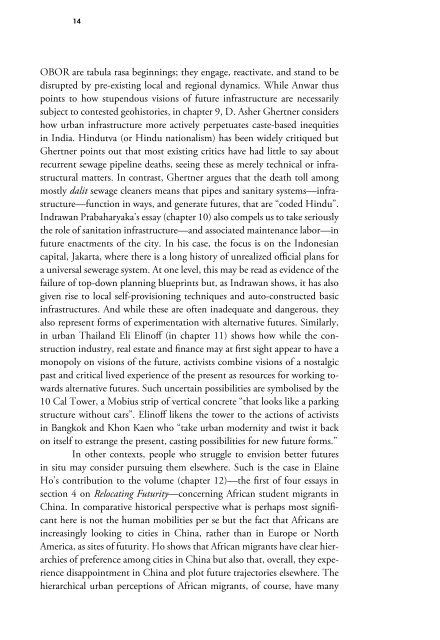Urban Asias – Essays on Futurity Past and Present
Create successful ePaper yourself
Turn your PDF publications into a flip-book with our unique Google optimized e-Paper software.
14 <br />
OBOR are tabula rasa beginnings; they engage, reactivate, <strong>and</strong> st<strong>and</strong> to be<br />
disrupted by pre-existing local <strong>and</strong> regi<strong>on</strong>al dynamics. While Anwar thus<br />
points to how stupendous visi<strong>on</strong>s of future infrastructure are necessarily<br />
subject to c<strong>on</strong>tested geohistories, in chapter 9, D. Asher Ghertner c<strong>on</strong>siders<br />
how urban infrastructure more actively perpetuates caste-based inequities<br />
in India. Hindutva (or Hindu nati<strong>on</strong>alism) has been widely critiqued but<br />
Ghertner points out that most existing critics have had little to say about<br />
recurrent sewage pipeline deaths, seeing these as merely technical or infrastructural<br />
matters. In c<strong>on</strong>trast, Ghertner argues that the death toll am<strong>on</strong>g<br />
mostly dalit sewage cleaners means that pipes <strong>and</strong> sanitary systems—infrastructure—functi<strong>on</strong><br />
in ways, <strong>and</strong> generate futures, that are “coded Hindu”.<br />
Indrawan Prabaharyaka’s essay (chapter 10) also compels us to take seriously<br />
the role of sanitati<strong>on</strong> infrastructure—<strong>and</strong> associated maintenance labor—in<br />
future enactments of the city. In his case, the focus is <strong>on</strong> the Ind<strong>on</strong>esian<br />
capital, Jakarta, where there is a l<strong>on</strong>g history of unrealized official plans for<br />
a universal sewerage system. At <strong>on</strong>e level, this may be read as evidence of the<br />
failure of top-down planning blueprints but, as Indrawan shows, it has also<br />
given rise to local self-provisi<strong>on</strong>ing techniques <strong>and</strong> auto-c<strong>on</strong>structed basic<br />
infrastructures. And while these are often inadequate <strong>and</strong> dangerous, they<br />
also represent forms of experimentati<strong>on</strong> with alternative futures. Similarly,<br />
in urban Thail<strong>and</strong> Eli Elinoff (in chapter 11) shows how while the c<strong>on</strong>structi<strong>on</strong><br />
industry, real estate <strong>and</strong> finance may at first sight appear to have a<br />
m<strong>on</strong>opoly <strong>on</strong> visi<strong>on</strong>s of the future, activists combine visi<strong>on</strong>s of a nostalgic<br />
past <strong>and</strong> critical lived experience of the present as resources for working towards<br />
alternative futures. Such uncertain possibilities are symbolised by the<br />
10 Cal Tower, a Mobius strip of vertical c<strong>on</strong>crete “that looks like a parking<br />
structure without cars”. Elinoff likens the tower to the acti<strong>on</strong>s of activists<br />
in Bangkok <strong>and</strong> Kh<strong>on</strong> Kaen who “take urban modernity <strong>and</strong> twist it back<br />
<strong>on</strong> itself to estrange the present, casting possibilities for new future forms.”<br />
In other c<strong>on</strong>texts, people who struggle to envisi<strong>on</strong> better futures<br />
in situ may c<strong>on</strong>sider pursuing them elsewhere. Such is the case in Elaine<br />
Ho’s c<strong>on</strong>tributi<strong>on</strong> to the volume (chapter 12)—the first of four essays in<br />
secti<strong>on</strong> 4 <strong>on</strong> Relocating <strong>Futurity</strong>—c<strong>on</strong>cerning African student migrants in<br />
China. In comparative historical perspective what is perhaps most significant<br />
here is not the human mobilities per se but the fact that Africans are<br />
increasingly looking to cities in China, rather than in Europe or North<br />
America, as sites of futurity. Ho shows that African migrants have clear hierarchies<br />
of preference am<strong>on</strong>g cities in China but also that, overall, they experience<br />
disappointment in China <strong>and</strong> plot future trajectories elsewhere. The<br />
hierarchical urban percepti<strong>on</strong>s of African migrants, of course, have many


















